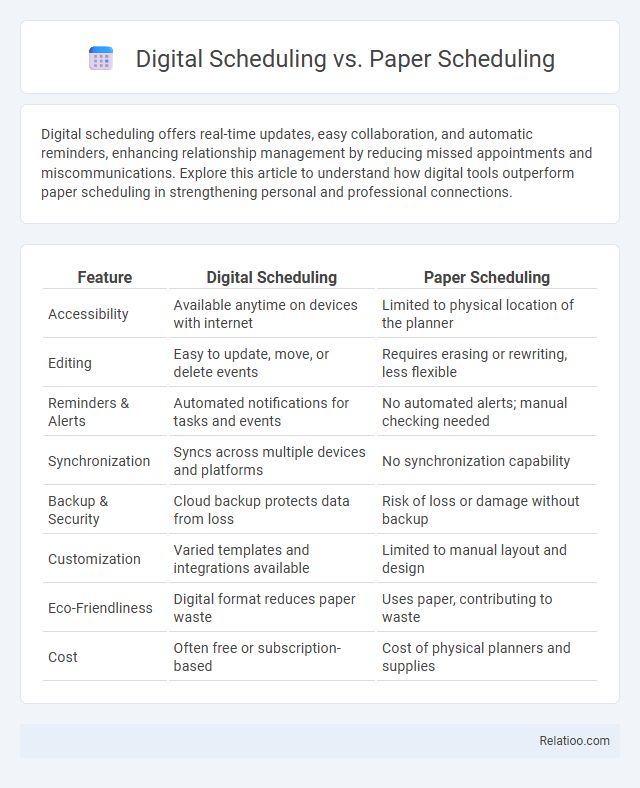Digital scheduling offers real-time updates, easy collaboration, and automatic reminders, enhancing relationship management by reducing missed appointments and miscommunications. Explore this article to understand how digital tools outperform paper scheduling in strengthening personal and professional connections.
Table of Comparison
| Feature | Digital Scheduling | Paper Scheduling |
|---|---|---|
| Accessibility | Available anytime on devices with internet | Limited to physical location of the planner |
| Editing | Easy to update, move, or delete events | Requires erasing or rewriting, less flexible |
| Reminders & Alerts | Automated notifications for tasks and events | No automated alerts; manual checking needed |
| Synchronization | Syncs across multiple devices and platforms | No synchronization capability |
| Backup & Security | Cloud backup protects data from loss | Risk of loss or damage without backup |
| Customization | Varied templates and integrations available | Limited to manual layout and design |
| Eco-Friendliness | Digital format reduces paper waste | Uses paper, contributing to waste |
| Cost | Often free or subscription-based | Cost of physical planners and supplies |
Introduction to Scheduling Methods
Scheduling methods vary widely, with digital scheduling offering automated reminders, real-time updates, and seamless integration across devices, enhancing your organizational efficiency. Paper scheduling, though traditional, provides a tactile and visual approach to managing appointments without reliance on technology or power sources, appealing to those who prefer analog tools. Understanding these distinct scheduling approaches helps you select the most effective system tailored to your productivity and workflow preferences.
Overview of Digital Scheduling
Digital scheduling enhances efficiency by automating appointment management and providing real-time updates, unlike traditional paper schedules that rely on manual entries prone to errors. Your access to cloud-based platforms enables seamless collaboration, instant notifications, and integration with other digital tools, optimizing time management and resource allocation. This technological shift reduces administrative burdens while improving accuracy and accessibility across multiple devices.
Overview of Paper Scheduling
Paper scheduling relies on physical calendars and planners, offering a tangible way to organize appointments and tasks but lacking real-time updates and automated reminders. Your ability to quickly adjust or share schedules is limited compared to digital solutions that provide synchronization across devices and collaborative features. Despite its simplicity, paper scheduling may pose challenges in managing complex or dynamic schedules efficiently.
Efficiency and Time Management
Digital scheduling enhances efficiency and time management by automating reminders, enabling easy adjustments, and offering real-time updates, which minimizes errors common in paper scheduling. Paper scheduling often results in increased time spent on manual entries and risk of lost or misread information, slowing down your workflow. Scheduling methods that combine digital tools with intuitive design significantly improve your ability to manage tasks and deadlines effectively.
Accessibility and Flexibility
Digital scheduling offers superior accessibility by enabling you to manage appointments anytime and anywhere through smartphones, tablets, or computers. Paper scheduling is limited by physical access and manual updates, reducing flexibility and increasing the risk of errors. Scheduling tools with cloud integration enhance your flexibility by syncing across multiple devices, ensuring seamless updates and collaboration.
Cost Comparison
Digital scheduling significantly reduces costs by minimizing paper usage, printing expenses, and administrative overhead compared to traditional paper scheduling. Cloud-based platforms offer scalable subscription models that eliminate the need for physical storage and streamline workforce management, resulting in lower operational costs. While basic scheduling involves manual input and potential errors, digital solutions provide automated updates and integration with payroll systems, enhancing cost efficiency and accuracy.
Security and Data Privacy
Digital scheduling platforms leverage encryption and secure cloud storage to protect user data, offering robust access controls and audit trails that enhance security and privacy. In contrast, paper scheduling is vulnerable to physical loss, unauthorized access, and lacks any data encryption, making it less secure for sensitive information. Traditional scheduling methods may rely on unsecured communication channels, increasing the risk of data breaches compared to modern digital solutions designed with privacy compliance standards such as GDPR and HIPAA.
Environmental Impact
Digital scheduling significantly reduces paper waste by eliminating the need for printed calendars and physical planners, supporting your commitment to sustainability. Paper scheduling contributes to deforestation, increased carbon emissions, and landfill accumulation. Scheduling through digital platforms leverages cloud storage and energy-efficient devices, decreasing environmental impact while enhancing accessibility.
User Experience and Adoption Challenges
Digital scheduling offers enhanced user experience through real-time updates, easy access across devices, and automated reminders, which significantly reduce manual errors and increase efficiency. Paper scheduling, while familiar and straightforward, poses challenges such as difficulty in scaling, limited collaboration, and risk of data loss, leading to lower adoption in dynamic environments. Your transition from paper to digital scheduling may face adoption barriers including resistance to change, learning curves, and integration with existing workflows, but overcoming these results in improved productivity and user satisfaction.
Choosing the Right Scheduling Solution
Choosing the right scheduling solution depends on the specific needs of a business, where digital scheduling offers real-time updates, automated reminders, and seamless integration with other software, enhancing efficiency and reducing errors. Paper scheduling, while simple and tangible, often lacks flexibility and scalability, making it prone to human error and difficult to manage for larger operations. Traditional scheduling methods may suffice for small teams but digital solutions deliver superior data management, accessibility, and collaboration for growing businesses seeking optimized workflow and productivity.

Infographic: Digital Scheduling vs Paper Scheduling
 relatioo.com
relatioo.com